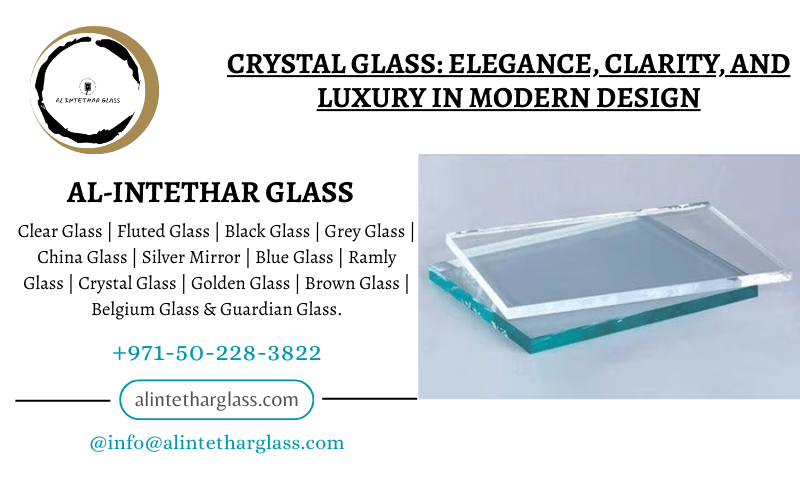Crystal Glass: Elegance, Clarity, and Luxury in Modern Design
Crystal Glass When it comes to glass products, Crystal Glass stands apart for its beauty, purity, and elegance. Unlike ordinary glass, crystal glass is admired for its high transparency, brilliant sparkle, and refined craftsmanship. It is not only used for decorative purposes but also in architecture, luxury interiors, and fine tableware. Over the centuries, crystal glass has become a symbol of prestige and sophistication, blending artistry with functionality.
In this article, we will explore what crystal glass is, its properties, advantages, applications, history, and role in modern design.

What is Crystal Glass?
Crystal glass is a type of premium-quality glass known for its exceptional clarity, brilliance, and often a higher refractive index than regular glass. Traditionally, crystal glass contained lead oxide, which gave it extra sparkle and weight. However, modern crystal glass is often produced with alternatives like barium oxide, zinc oxide, or potassium oxide, making it safer while maintaining its brilliance.
Crystal glass is often associated with luxury tableware, chandeliers, decorative items, and architectural applications where transparency and elegance are essential.
Key Features of Crystal Glass
- High Clarity and Transparency
- Crystal glass allows maximum light transmission, resulting in exceptional brightness.
- Brilliance and Sparkle
- Crystal Glass Its refractive index gives it a diamond-like sparkle, especially under light.
- Smooth Surface Finish
- Crystal glass is polished to perfection, offering a flawless finish.
- Durability
- Despite its delicate appearance, high-quality crystal glass is strong and long-lasting.
- Sound Resonance
- Crystal Glass glassware produces a distinctive, melodic “ring” when tapped, unlike regular glass.
- Variety of Designs
- Can be cut, engraved, frosted, or molded into intricate patterns and shapes.
Advantages of Crystal Glass
- Aesthetic Beauty
- Adds a touch of elegance and luxury to interiors, lighting, and tableware.
- Premium Quality
- Known for refinement and used in high-end projects.
- Enhanced Light Play
- Crystal Glass refracts and reflects light beautifully, creating dazzling effects.
- Design Flexibility
- Can be shaped into chandeliers, vases, glasses, windows, and decorative panels.
- Luxury Appeal
- Associated with sophistication, making it a popular choice in fine dining, hospitality, and luxury homes.
Applications of Crystal Glass
Crystal glass has versatile applications, ranging from decorative items to modern architecture:
1. Tableware and Drinkware
- Crystal glasses, bowls, and plates are famous worldwide.
- Used in luxury dining experiences for their clarity and brilliance.
2. Lighting and Chandeliers
- Crystal Glass chandeliers are a hallmark of luxury, refracting light into stunning patterns.
3. Interior Decoration
- Decorative mirrors, partitions, and wall panels often use crystal glass for a high-end look.
4. Architecture
- Crystal Glass Used in windows, facades, and glass walls where transparency and elegance matter.
5. Jewelry and Accessories
- Crystal glass beads and stones are used in jewelry, ornaments, and fashion.
6. Awards and Trophies
- Clear and elegant crystal glass is widely used in corporate awards and recognition trophies.
Manufacturing Process of Crystal Glass
The production of crystal glass requires a careful blend of raw materials and advanced techniques:
- Selection of Raw Materials
- High-quality silica sand, soda ash, and refining agents are used.
- Additional oxides (lead, barium, zinc, or potassium) are added for brilliance.
- Melting
- Raw materials are melted in a furnace at temperatures above 1400°C.
- Forming and Shaping
- The molten glass is shaped into desired forms using molds, blowing techniques, or handcrafting.
- Cutting and Engraving
- Crystal glass is cut, faceted, or engraved to enhance sparkle and design.
- Polishing
- Surfaces are polished to achieve flawless transparency and shine.
- Quality Testing
- Each piece is tested for clarity, brilliance, and structural strength.
Types of Crystal Glass
- Lead Crystal
- Contains lead oxide for added brilliance and weight (traditional type).
- Crystal Glass Without Lead
- Uses barium, zinc, or potassium oxides as safe alternatives.
- Cut Crystal
- Features hand-cut or machine-cut patterns that reflect light beautifully.
- Colored Crystal Glass
- Tinted with minerals to produce elegant shades like blue, red, or green.
- Pressed Crystal
- Mass-produced but retains brilliance and elegance.
Crystal Glass vs. Regular Glass
| Feature | Crystal Glass | Regular Glass |
|---|---|---|
| Transparency | Higher clarity & brilliance | Normal clarity |
| Weight | Heavier due to additives | Lighter |
| Sound | Rings melodically when tapped | Dull sound |
| Applications | Luxury & decorative use | Everyday utility use |
| Cost | More expensive | Relatively cheaper |
History of Crystal Glass
The art of crystal glass dates back to 17th-century Europe, particularly in Venice and Bohemia. Venetian artisans pioneered techniques for glass clarity, while Bohemia (present-day Czech Republic) became famous for its cut crystal glass. Over the centuries, crystal glass spread across Europe and the world, becoming a symbol of royalty, fine dining, and architectural luxury.
Role of Crystal Glass in Modern Architecture and Design
In contemporary times, crystal glass is no longer limited to chandeliers and tableware. It has entered modern architecture and interiors in significant ways:
- Hotels and Resorts use crystal glass in lobbies, decorative partitions, and lighting.
- Luxury Homes incorporate crystal elements in stair railings, wall décor, and windows.
- Corporate Spaces use crystal awards, panels, and decorative glass to enhance aesthetics.
With its ability to combine functionality and beauty, crystal glass continues to be a timeless choice for design innovation.
Sustainability Aspect
Modern crystal glass manufacturers are focusing on lead-free production and eco-friendly recycling processes. Since glass is 100% recyclable, crystal glass aligns with sustainable construction and interior design practices, contributing to greener living.
Maintenance of Crystal Glass
To preserve the beauty of crystal glass, proper care is essential:
- Wash crystal glassware with mild soap and lukewarm water.
- Avoid harsh abrasives or strong detergents.
- Dry with a soft cloth to prevent water spots.
- For architectural crystal glass, use gentle cleaning solutions to maintain clarity.
Conclusion
Crystal Glass is not just a material; it is a symbol of elegance, luxury, and sophistication. With its exceptional clarity, brilliance, and ability to elevate any space, crystal glass has remained a favorite for centuries. From royal palaces to modern skyscrapers, from delicate wine glasses to grand chandeliers, crystal glass continues to shine as a timeless choice for beauty and functionality.
Its combination of aesthetic charm, durability, and versatility ensures that crystal glass will remain a premium material in interior design, architecture, and fine living for generations to come.
Tags: Clear Glass Sheets, Commercial Glass Solutions, crystal glass, Decorative Glass, glass for interiors, High-Quality Glass, Modern Glass Designs, Premium Glass Panels, Residential Glass Solutions, Transparent Glass Sheets

